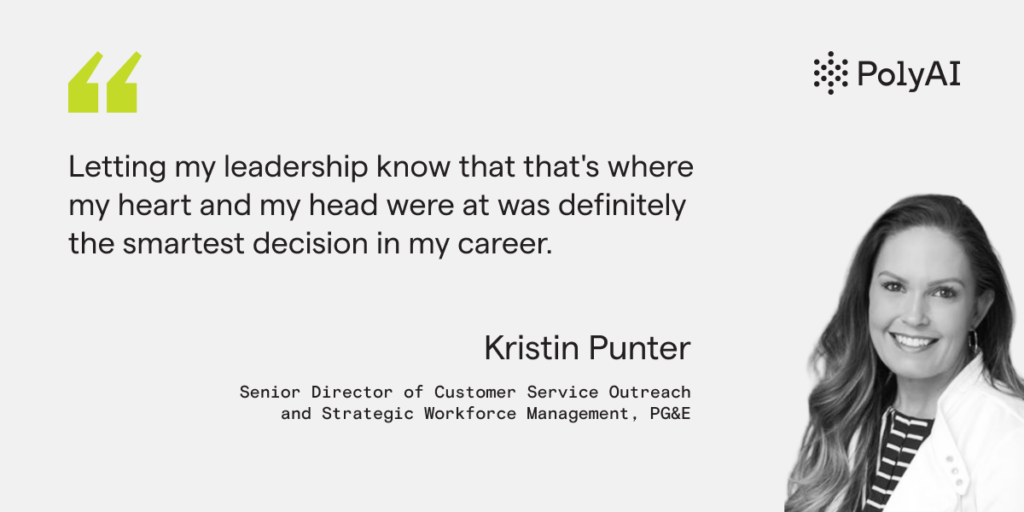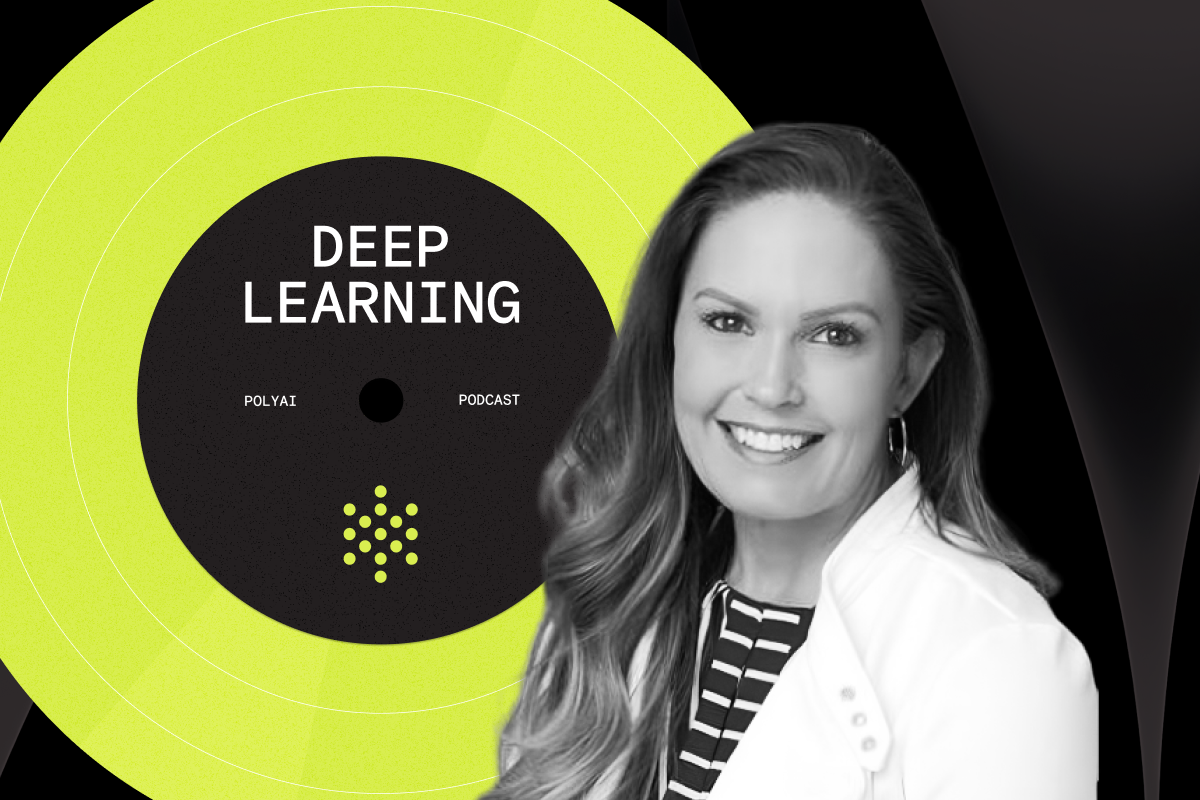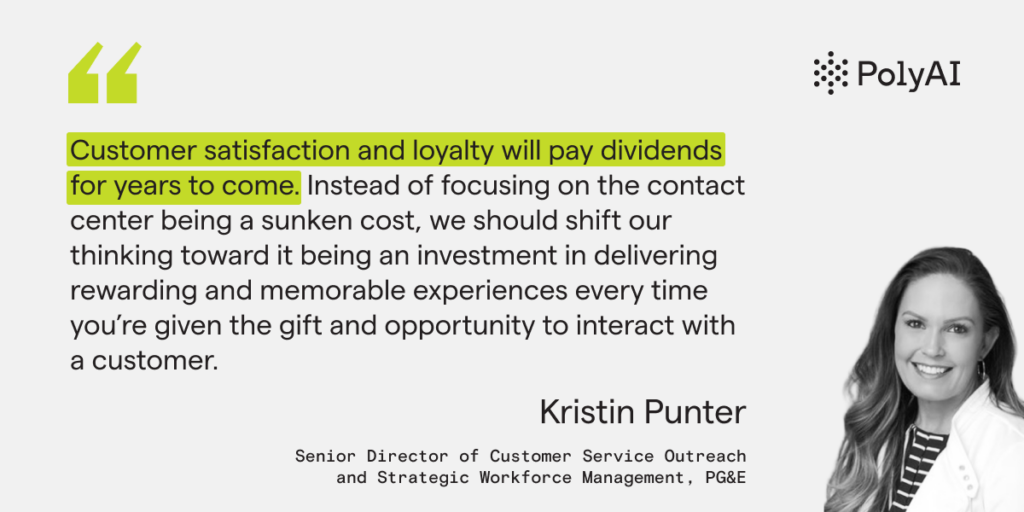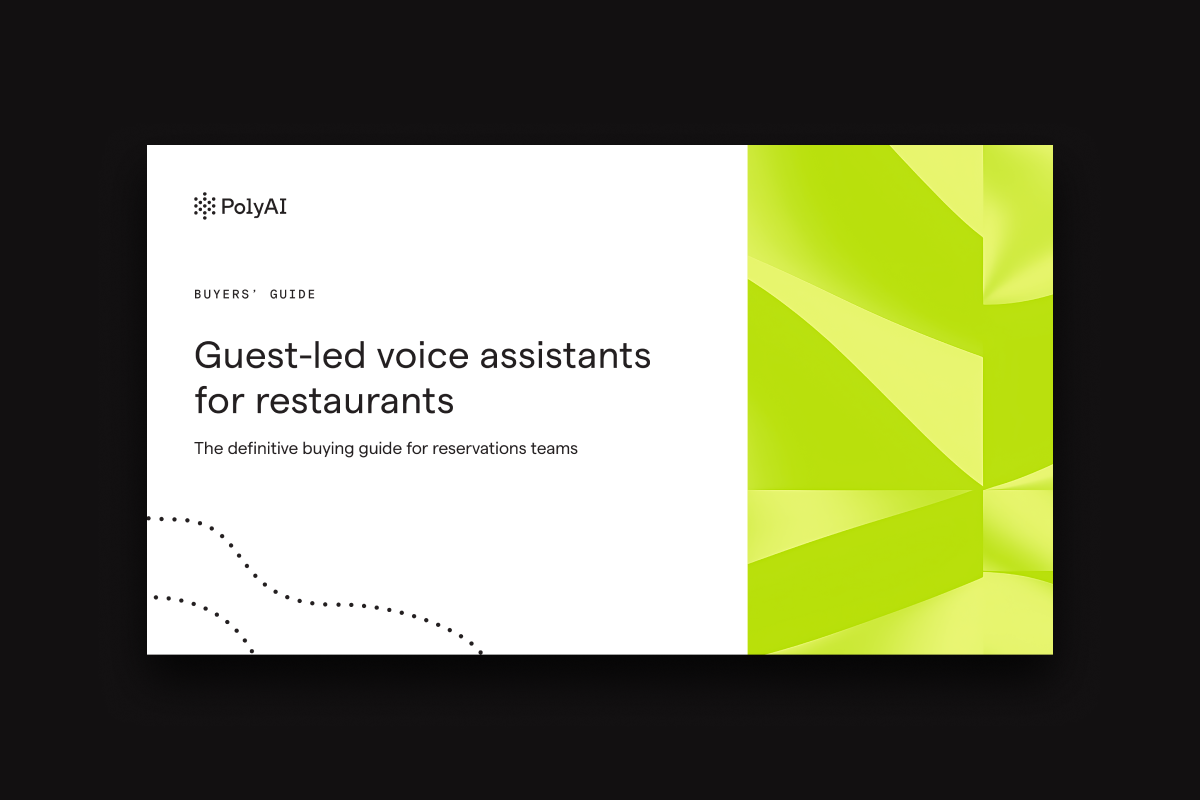Kristin Punter, Senior Director of Customer Service Outreach and Strategic Workforce Management at Pacific Gas and Electric (PG&E) Company, recently joined PolyAI’s Kylie Whitehead to share her journey from starting as a customer service representative (CSR) to her current role.
Could you start by telling us a bit more about your career to date?
Back in college, I was a retail manager. Tech was up and coming, particularly in the wireless telecom industry. I took a step back and took a job as a customer service representative in the wireless industry. Back then, many of us didn’t even have cell phones the way we do today, and there was certainly no caller ID, so it was a very different world back then!
I didn’t want to stay in retail, so I started as a representative and worked my way up to a help desk tech. Then, I went into leadership and became a call center supervisor. When I was a call center supervisor, probably the smartest career decision of my entire life was looking at what I liked about the job, what I didn’t like, and what I was most interested in. I was most interested in the workforce management piece of things.
I was fascinated with their forecasting abilities and capacity planning. At the time, my senior leaders were looking at me, saying “Do you want to be promoted to a manager position’.
I said, if it’s not workforce management, I’m really not interested. Throwing that out there proactively, letting my leadership know that that’s where my heart and my head were, was the smartest decision in my career. So when an opportunity came up in the workforce management realm, I was fortunate enough to get that job.
So I became a manager of workforce management, and then I became a regional area manager. I had the Western region under my leadership at AT&T Wireless at the time.

I wasn’t looking for a job, but one day I got a phone call from PG&E who said, “We’re starting a new workforce management department, and we’d like you to lead it.” And like I said, I wasn’t looking, but my girls were young, I was traveling a lot, and to be able to spend less time on the road was a big selling point for me! And it was exciting that they were starting a whole new team that I had the opportunity to lead.
That was 17 years ago, and I joined PG&E as the manager of the workforce management team. And I will tell you, going from a regional area manager position to a manager position felt weird to me.
It seemed like a step back, but realistically, once I got in and learned more about PG&E, if you looked at industry to industry, from where I came from, it was a little bit different in leveling, whereas it was more like a director-level position. So it felt like a step up, even though the title didn’t suggest that.
Then, throughout the 17 years, I worked my way from manager to director to senior director at PG&E.
What a resume! So, a lot must have changed in those 17 years. What have you seen changing in the customer service landscape in that time?
Keeping the customer at the center of everything we do and think about hasn’t changed. Certainly, there have been shifts. It’s that age-old pendulum where it’s cost this year, and then it’s service this year, and how do you become great at both? That’s never going to change.
But I think the technology space is really over the 17 years where I’ve seen the biggest shift.
I think that a lot of contact center leaders will be able to empathize with that pendulum effect! What advice would you give for communicating the value of what you do upwards, in that it’s not just a cost center?
That’s the age-old question, you know, is it a cost center or a value channel? Oh, the struggle!
I’m fortunate because my senior leaders are already bought in, so I don’t really have to sell it much, but customer service is the value, and it’s one you can’t put a price tag on.
Customer satisfaction and loyalty will pay dividends for years to come. Instead of focusing on the contact center being a sunken cost, we should shift our thinking toward it being an investment in delivering rewarding and memorable experiences every time you’re given the gift and opportunity to interact with a customer.
It’s about making each experience count more than it is about the cost to serve because you can’t put a price tag on customer satisfaction. You just can’t.
I love the concept that every customer interaction is a gift. I bet it didn’t always feel like that when you were a rep though! What do you think you learned in that time as a rep that has enabled you to do so well in your career?
Giving attention to one customer at a time is something that has parlayed elsewhere in my career. In today’s climate, many of us work remotely all the time, and we have just become multitaskers. We’re not present. We’re not fully engaged. We’re not fully listening.
When you’re a customer service rep, you have no choice but to be fully engaged without distractions. You already have enough distractions between all the different windows that you have to navigate in order to service the customer. But you don’t have chats, emails, cell phone texts, and everything else going on at the same time that we do in our normal course in leadership roles. That’s probably the biggest takeaway that I can get from that position, which is just being present.
And that’s something I’ve found really useful in my personal life too! I no longer go to a restaurant with a friend and have my cell phone on the table. It’s basically saying, I don’t value your time, so I purposely and intentionally don’t allow those distractions. Which is sometimes hard to do at work!
Stay tuned for part two of the interview, where Kristin discusses the innovative steps Pacific Gas and Electric Company (PG&E) is taking with their AI voice assistant, ‘Peggy,’ to provide real-time, efficient, and personalized customer service.





